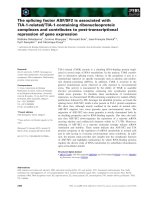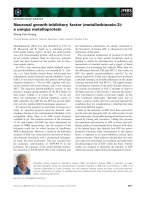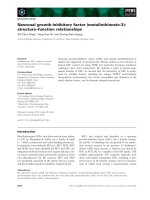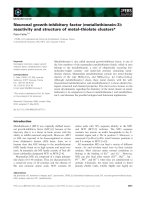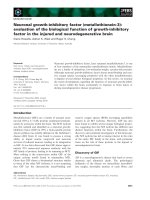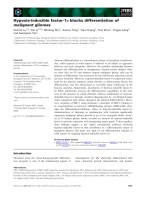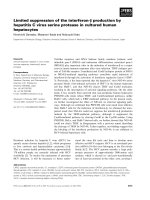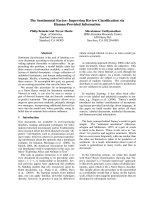Báo cáo khoa học: Hepatocyte growth factor activator (HGFA): its regulation by protein C inhibitor ppt
Bạn đang xem bản rút gọn của tài liệu. Xem và tải ngay bản đầy đủ của tài liệu tại đây (301.53 KB, 7 trang )
MINIREVIEW
Hepatocyte growth factor activator (HGFA): its regulation
by protein C inhibitor
Koji Suzuki
Department of Molecular Pathobiology, Mie University Graduate School of Medicine, Japan
Introduction
Protein C inhibitor (PCI; SERPINA5), a member of
the plasma serine protease inhibitor (serpin) family, was
isolated from human plasma as an inhibitor of activated
protein C (APC), the major protease of the anticoagu-
lant protein C pathway, which regulates thrombosis
and hemostasis [1]. PCI, an irreversible inhibitor, forms
an acyl-bonded complex with APC, and complex for-
mation is enhanced in the presence of heparin [2]. In
humans, the liver is the main source of plasma PCI [3],
and PCI synthesis also occurs in the kidneys [3], lungs,
pancreas, spleen, megakaryocytes, platelets [4], and
reproductive organs, including testis, epididymis,
prostate, and seminal vesicles [5]. Because of its broad
tissue distribution, human PCI may regulate several
physiological and pathological events in which serine
proteases are involved, and its molecular targets may
include APC and thrombomodulin–thrombin [6], which
play roles in the anticoagulant protein C pathway,
thrombin and plasma kallikrein [7], which play roles in
the blood coagulation pathway, plasminogen activators
released during matrix invasion by tumor cells [8], and
acrosin in the fertilization system [9]. Thus, PCI plays
many physiological and pathological roles beyond
thrombosis and hemostasis in humans [10]. However, in
rodents, including rats and mice, PCI is detected only in
the testes and ovaries, and not in the liver or plasma
[11,12]. Therefore, to study the physiological and path-
ological roles of PCI in experimental disease animal
models, we established human PCI-transgenic (hPCI-
Tg) mice that mimic PCI expression in humans; in this
Keywords
activated protein C; hepatocyte growth
factor (HGF); HGF activator; liver
regeneration; protein C inhibitor
Correspondence
K. Suzuki, Department of Molecular
Pathobiology, Mie University Graduate
School of Medicine, Edobashi 2-174,
Tsu-city, Mie 514-8507, Japan
Fax: +81 59 231 9797
Tel: +81 59 231 9702
E-mail:
(Received 30 November 2009, revised
29 January 2010, accepted 26 February
2010)
doi:10.1111/j.1742-4658.2010.07639.x
Protein C inhibitor (PCI; SERPINA5) is a plasma serine protease inhibitor,
and a potent inhibitor of activated protein C (APC), which plays a critical
role in the anticoagulant protein C pathway. Recently, PCI was also found
to form a complex with the serine protease hepatocyte growth factor
activator (HGFA), inhibiting the HGFA-catalyzed activation of the single-
chain hepatocyte growth factor precursor. In vivo studies using human
PCI-transgenic (hPCI-Tg) mice, which mimic PCI expression in humans,
showed that the regeneration rate of the liver after partial hepatectomy
was significantly impaired as compared with wild-type mice. The decreased
liver regeneration in hPCI-Tg mice was restored by pretreatment with anti-
body against human PCI. Furthermore, APC protected hepatic nonparen-
chymal cells from thrombin-induced inflammation in vitro, suggesting that
plasma PCI may inhibit the cytoprotective action of APC on hepatic cells
in hPCI-Tg mice. It was shown that the levels of HGFA–PCI are increased
in plasma of patients who have been subjected to hepatectomy, as com-
pared with complex levels in the plasma of normal individuals. Thus, PCI
may play a role as a potent inhibitor of HGFA and APC in plasma and ⁄ or
at the sites of tissue injury in the regulation of tissue regeneration.
Abbreviations
APC, activated protein C; BrdU, bromodeoxyuridine; HAI, hepatocyte growth factor activator inhibitor; HGF, hepatocyte growth factor;
HGFA, hepatocyte growth factor activator; hPCI-Tg, human protein C inhibitor-transgenic; PCI, protein C inhibitor; PDB, Protein Data Bank.
FEBS Journal 277 (2010) 2223–2229 ª 2010 The Author Journal compilation ª 2010 FEBS 2223
model, high levels of human PCI are detected in plasma
and in selected organs, including the liver [13].
Hepatocyte growth factor (HGF) plays a critical role
in the regeneration of various tissues, including the
liver, by stimulating the proliferation and motility of
various types of cell, including epithelial and endothe-
lial cells [14]. HGF is synthesized and secreted as an
inactive single-chain precursor from liver sinusoidal
endothelial cells and megakaryocytes (platelets) [15].
Limited proteolytic activation of this precursor is
required for the biological activity of HGF [16]. The
most potent activator of HGF precursor is HGF acti-
vator (HGFA), a serine protease homologous to coag-
ulation factor XIIa [17,18]. HGFA is synthesized in
hepatocytes, and its zymogen, pro-HGFA, circulates in
blood as a 98 kDa single-chain form [18,19]. Thrombin
generated at sites of tissue injury activates pro-HGFA
by limited proteolysis, generating an activated 98 kDa
two-chain form of HGFA that contains a disulfide-
linked 65 kDa heavy chain and a 31 kDa light chain
[18,20,21]. The HGFA heavy chain is then further
cleaved in the systemic circulation by plasma kallik-
rein, releasing the 34 kDa mature form of HGFA
[20,21]. Recently, cell membrane-bound Kunitz-type
HGFA inhibitors (HAIs) were isolated [22,23], and it
was determined that HAI-1 acts as an inhibitor and a
receptor of HGFA on the cell surface [24,25].
We recently found that PCI inhibits HGFA by form-
ing HGFA–PCI in the absence of heparin, and inhibits
HGFA-catalyzed activation of HGF precursor in vitro
[26]. To determine the pathophysiological significance
of PCI inhibition of HGFA, we investigated the influ-
ence of PCI on liver regeneration, using hPCI-Tg mice,
and found that PCI decreased the regeneration rate of
the liver after hepatectomy by forming HGFA–PCI.
Furthermore, PCI aggravated hepatic nonparenchymal
cell injury by inhibiting the cytoprotective effects of
APC [27]. The levels of HGFA–PCI in the plasma of
patients who had been subjected to hepatectomy were
found to be significantly increased as compared with
levels in the plasma of normal individuals [26,27].
In this review, I describe the mechanism of regulation
of HGFA by PCI in vitro, a possible role of PCI in liver
regeneration triggered by HGFA in the mouse model,
and clinical data related to the regulation of HGFA
by PCI in patients and normal individuals after
hepatectomy.
PCI inhibits HGFA by forming
HGFA–PCI independently of heparin
Thrombin-catalyzed activation of pro-HGFA is
enhanced in the presence of heparin, and this
pro-HGFA activation by thrombin appears to be sig-
nificantly inhibited by PCI. Furthermore, PCI was
found to inhibit activated HGFA directly and potently
in the absence of heparin [26]. PCI inhibits the 34 and
98 kDa forms of HGFA equally, with apparent inhibi-
tion constants (K
i
) of 6.1 nm and 6.3 nm, respectively
[26]. The second-order rate constants (m
)1
Æs
)1
) of the
reaction between 34 kDa HGFA and PCI in the pres-
ence or absence of heparin (10 unitsÆmL
)1
) were
6.6 · 10
4
and 6.3 · 10
4
, respectively. The residual
amidolytic activity of HGFA decreased concomitantly
with increased HGFA–PCI formation, as determined
by SDS ⁄ PAGE and western blotting, with an inverse
relationship being observed between HGFA inhibition
by PCI and HGFA–PCI formation. HGFA–PCI for-
mation was also observed in plasma in vitro. When
HGFA was added to human plasma, the concentration
of HGFA–PCI increased in a time-dependent manner.
PCI also inhibits the HGFA-catalyzed activation of
HGF precursor [26]. In the absence of PCI, almost all
of the single-chain HGF precursor was activated by
HGFA, releasing the 98 kDa disulfide-linked active
form of HGF. In contrast, in the presence of PCI-pre-
treated HGFA, the single-chain HGF precursor was
minimally converted into the two-chain form.
HGFA–PCI formation was competitively inhibited
by APC in the presence of heparin. PCI inhibits APC
with an apparent K
i
of 14 nm and second-order rate
constants (m
)1
Æs
)1
) of 1.3 · 10
4
in the absence of hepa-
rin and 6.5 · 10
5
in the presence of heparin [1,2]. To
evaluate whether APC and HGFA are competitive tar-
gets of PCI in plasma, the effect of APC on HGFA–
PCI formation was examined in the presence or absence
of heparin. APC competitively inhibited HGFA–PCI
formation in the presence of heparin, but exhibited only
a weak inhibitory effect in the absence of heparin;
in this latter condition, PCI effectively inhibits HGFA
[26]. Plasma kallikrein competitively inhibited
HGFA–PCI formation in the presence and absence of
heparin.
Structural analysis of APC–PCI and
HGFA–PCI formation
To study the different effects of heparin on APC–PCI
and HGFA–PCI formation, three-dimensional models
of both complexes were constructed by using the three-
dimensional structure of the trypsin–serpin Michaelis
complex [Protein Data Bank (PDB) accession number:
1K9O] for the reference template, as described previ-
ously [26]. The sequences of human pro-HGFA prote-
ase domain (Swiss-Prot accession number: Q04756)
and of the human PCI domain (PIR accession number:
HGFA: its regulation by protein C inhibitor K. Suzuki
2224 FEBS Journal 277 (2010) 2223–2229 ª 2010 The Author Journal compilation ª 2010 FEBS
A39339) were compared with the PDB structures of
trypsin and serpin, respectively, and this was followed
by standard homology modeling and energy minimiza-
tion procedures. Figure 1A shows three-dimensional
structures with docking models of PCI and APC or
HGFA. In these models, the estimated heparin-binding
sites are Arg269-Lys270 of the PCI H-helix [28] and
the 37-loop structure of APC, containing Lys37-Lys38-
Lys39 [29]. Figure 1B shows the detailed structures of
the docking models of PCI and APC or HGFA. In the
PCI–APC model, PCI Arg362, which is the first resi-
due of the s1C strand after the reactive center loop, is
estimated to be the nearest residue to the 37-loop
structure of APC, and the distances from Arg362 of
PCI to Lys37 and Lys39 are estimated to be 6.8 and
5.6 A
˚
, respectively. These values are small enough for
positive charge repulsion to exist between PCI and
APC in the absence of heparin. This repulsion can be
neutralized by heparin, as Lys37 and Lys39 from APC
interact with heparin. On the other hand, the 37-loop
structure in APC is replaced by Ile35-Gly36-Asp37 in
HGFA. The negatively charged Asp37 of HGFA is
located very near (7.6 A
˚
) to Arg362 of PCI. As Asp37
of HGFA is able to interact strongly with Arg362 of
37-loop
A
B
(K37-K38-K39)
(I35-G36-D37)
R362
R362
K270
R269
K270
R269
on
on H-helix
on H-helix
K38
I 35
G36
K37
K39
D37
R362
R362
Fig. 1. (A) Spatial representation of molecular homology between APC–PCI (left) and HGFA–PCI (right). APC (green), HGFA (red–orange) and
PCI (gray) are shown as ribbon models. In each complex, acidic and basic amino acids are in red and blue, respectively. There is no basic
residue in the loop structure (Ile35-Gly36-Asp37) of HGFA that corresponds with the 37-loop structure of APC. Heparin is estimated to bind
to Lys269-Lys270 on the H-helix of PCI [28] and the 37-loop structure of APC containing Lys37-Lys38-Lys39 [29]. (B) Comparative molecular
modeling of the reactive center loop region of PCI with the 37-loop of APC (left) and HGFA (right). APC (green), HGFA (red–orange) and PCI
(gray) are shown as ribbon models. The reactive center loop structure of PCI is gold-colored. The space occupied by Lys37, Lys38, and
Lys39, forming the 37-loop structure of APC, is occupied by Ile35, Gly36 and Asp37 in the homology model of HGFA. Hydrogen atoms are
not displayed for clarity. The distances from Arg362 of PCI to Lys37 and Lys39 of APC in APC–PCI are estimated to be 6.8 and 5.6 A
˚
,
respectively, in the absence of heparin. The blue dotted arrows indicate repulsion between Arg362 of PCI and Lys37 or Lys39 of APC. The
distance from Arg362 of PCI to Asp37 of HGFA in HGFA–PCI is estimated to be 7.6 A
˚
in the absence of heparin. The red dotted arrow indi-
cates an interaction between Arg362 of PCI and Asp37 of HGFA. These models are in part modified from Fig. 10 of our previous article [26].
K. Suzuki HGFA: its regulation by protein C inhibitor
FEBS Journal 277 (2010) 2223–2229 ª 2010 The Author Journal compilation ª 2010 FEBS 2225
PCI, we hypothesize that heparin does not affect PCI
inhibition of HGFA.
To confirm this hypothesis, we compared the inhibi-
tion of HGFA by recombinant mutated PCI (R362A-
PCI; Arg362 replaced by Ala) and that by wild-type
PCI in the presence or absence of heparin. The data
showed that the inhibitory activity of R362A-PCI
against HGFA in the absence of heparin was markedly
decreased as compared with wild-type PCI, but it was
accelerated in the presence of heparin [26]. On the
other hand, the inhibition of APC by R362A-PCI was
relatively increased in the absence of heparin as com-
pared with wild-type PCI, and it was also accelerated
by heparin. These findings suggest that Arg362 of PCI
is important for HGFA inhibition.
Recently, Li et al. [30] determined a crystallographic
structure of the Michaelis complex of PCI, thrombin
and heparin to 1.6 A
˚
resolution, and found that
thrombin interacts with PCI, depending on the length
of PCI’s reactive center loop to align the heparin-bind-
ing sites of the two proteins, suggesting that the cofac-
tor activity of heparin depends on the formation of a
heparin-bridged Michaelis complex and substrate-
induced exosite contacts.
PCI regulates HGFA-mediated liver
regeneration in the mouse model
To investigate the influence of HGFA inhibition by
PCI in vivo, we compared liver regeneration after 70%
hepatectomy in wild-type and hPCI-Tg mice, which
mimic human PCI expression [27]. All procedures were
conducted according to the National Institutes of
Health guidelines for animal experiments, and the Mie
University Review Board approved the experimental
protocol for the animal investigation, as previously
described [27]. The livers of both wild-type and
hPCI-Tg mice started to regenerate by postoperative
day 5, and the liver weight in wild-type mice recovered
to preoperative levels by postoperative day 9.
However, in hPCI-Tg mice, the liver weight was below
normal on postoperative day 5 (about 80%), and took
up to 13 days to recover to the normal weight shown
in wild-type mice. To test liver regenerative ability,
bromodeoxyuridine (BrdU) incorporation and expres-
sion of cell proliferation markers, G
1
-phase cyclin D1
and S-phase cyclin A, were assessed in the remnant
livers. The BrdU labeling index peaked 48 h after
hepatectomy in hPCI-Tg and wild-type mice, but the
numbers of BrdU-positive cells were significantly
decreased in hPCI-Tg mouse livers at each time point
after hepatectomy (19.2 ± 2.5% in wild-type mice;
4.9 ± 0.1% in hPCI-Tg mice). The expression levels of
cyclin D1 and cyclin A were significantly decreased in
hPCI-Tg mice 48 h after hepatectomy. These findings
suggest that impaired liver regeneration in hPCI-Tg
mice was due to decreased hepatocyte proliferation.
To investigate the mechanism of impaired liver
regeneration in hPCI-Tg mice, the dynamics of
HGFA, PCI, HGFA–PCI and HGF were determined
at early stages after hepatectomy. Pro-HGFA mRNA
levels were the same in wild-type and hPCI-Tg naı
¨
ve
livers, and were upregulated to similar levels after hep-
atectomy [27]. The levels of active 34 kDa HGFA
protein in plasma of wild-type mice increased 10-fold
from preoperative levels 6 h after hepatectomy. How-
ever, they did not increase to the same levels in hPCI-Tg
mice; the highest active HGFA protein level (five-fold of
the preoperative stage) was observed at 12 h. The
plasma PCI levels in hPCI-Tg mice also decreased
rapidly after partial hepatectomy; the lowest PCI level
was observed 12 h postoperation, and it recovered at
48 h. Plasma HGFA–PCI was detected 12 h after hep-
atectomy in hPCI-Tg mice. The generation of activated
HGF was lower in hPCI-Tg mice than in wild-type
mice, and the activation rate of HGF in hPCI-Tg mice
was substantially lower than in wild-type mice
(63.1% ± 4.1% in wild-type mice; 43.0% ± 3.1% in
hPCI-Tg mice). These data suggest that HGF precur-
sor activation is impaired in the remnant liver of
hPCI-Tg mice because of HGFA–PCI formation.
Plasma PCI in hPCI-Tg mice inhibits the
cytoprotective activity of APC
The anticoagulant protease APC has marked cytopro-
tective and anti-inflammatory activities [31,32], and it
is generated from its precursor protein C by activation
with thrombin bound to thrombomodulin on the
vascular endothelial cells [33,34]. As PCI is a potent
inhibitor of both APC and thrombomodulin–throm-
bin, we hypothesized that hepatic nonparenchymal
cells are aggravated in hPCI-Tg mice after partial hep-
atectomy because of human PCI-mediated inhibition
of APC generation from protein C by thrombomodu-
lin–thrombin and the resulting loss of APC cytoprotec-
tive effects. Twenty-four hours after hepatectomy,
histological evaluation showed vacuolized hepatocytes
in the remnant livers of both wild-type and hPCI-Tg
mice [27]. However, sinusoidal congestion and bleeding
were detected focally in hPCI-Tg livers, and more sinu-
soidal fibrin deposition was observed in hPCI-Tg livers
than in wild-type livers at this time point. The plasma
hyaluronic acid concentration was higher in hPCI-Tg
mice than in wild-type mice at each time point after
hepatectomy, suggesting that severe sinusoidal
HGFA: its regulation by protein C inhibitor K. Suzuki
2226 FEBS Journal 277 (2010) 2223–2229 ª 2010 The Author Journal compilation ª 2010 FEBS
dysfunction occurs in hPCI-Tg mice. In vitro studies
showed that thrombin-induced interleukin-6 produc-
tion by cultured nonparenchymal cells isolated from
wild-type mice was similar to that by cells from
hPCI-Tg mice, and addition of exogenous APC
decreased thrombin-stimulated interleukin-6 produc-
tion in the nonparenchymal cells of both wild-type and
hPCI-Tg mice equally [27]. These findings suggest that
APC protects hepatic nonparenchymal cells from
thrombin-induced inflammation, and that plasma PCI
in hPCI-Tg mice inhibits the cytoprotective action of
APC and may also inhibit thrombomodulin–thrombin-
mediated APC generation.
To investigate the inhibitory effect of PCI in
HGFA-mediated liver regeneration and the cytoprotec-
tive activity of APC on hepatic nonparenchymal cells,
we evaluated the effect of treatment with antibody
against human PCI on hPCI-Tg mice [27]. The plasma
levels of snake venom (Protac)-activated APC activity
in hPCI-Tg mice were 35.8% ± 4.3% (P < 0.01) of
the plasma levels observed in wild-type mice. However,
after administration of antibody against human PCI
through the tail vein 12 h before hepatectomy and sub-
sequently every 72 h, APC activity in hPCI-Tg mice
increased to levels similar to those observed in wild-
type mice. The antibody showed no effect on liver
weight in wild-type mice; however, the antibody signifi-
cantly (P < 0.01) restored the impaired liver regenera-
tion in hPCI-Tg mice as compared with hPCI-Tg mice
treated with saline. The BrdU labeling index at 48 h in
the regenerated liver of the antibody-treated hPCI-Tg
mice increased significantly (12.1% ± 1.2%,
P < 0.01) as compared with hPCI-Tg mice treated
with saline and also significantly (P < 0.05) as com-
pared with wild-type mice. These data suggest that the
antibody against human PCI significantly improves
impaired liver regeneration in hPCI-Tg mice.
HGFA–PCI formation in human plasma
The concentrations of HGFA–PCI, pro-HGFA and
PCI in peripheral plasma obtained from normal sub-
jects and from patients with hepatitis or hepatocellular
carcinoma have been determined [26]. The plasma con-
centrations of pro-HGFA (40.2 ± 5.4 nm) and PCI
(115.4 ± 10.5 nm) in normal subjects were significantly
(P < 0.05) higher than in patients with hepatocellular
carcinoma (22.5 ± 4.5 and 55.7 ± 6.5 nm, respec-
tively). In addition, the plasma concentration of
HGFA–PCI was significantly (P < 0.01) higher in
hepatocellular carcinoma patients (60 ± 20 pm) than
in normal subjects (27 ± 10 pm). On the other hand,
the plasma concentrations of pro-HGFA and PCI were
not significantly different between hepatitis patients
and normal subjects, but the plasma levels of HGFA–
PCI were significantly (P < 0.01) higher in patients
with hepatitis (112 ± 50 pm) than in normal subjects.
The concentrations of PCI, pro-HGFA and HGFA–
PCI in plasma of normal individuals (n =6;
114.5 ± 18.4, 45.7 ± 6.2, and 30 ± 5 pm, respec-
tively, before hepatectomy) were also determined after
hepatectomy [27]. The plasma PCI level in human liver
donors rapidly decreased after hepatectomy. Concomi-
tantly with the decrease in plasma PCI level, pro-
HGFA and HGFA–PCI levels were significantly
increased, reaching peak levels 12 h after surgery
(a three-fold increase in pro-HGFA level and a 1.5-
fold increase in HGFA–PCI level as compared with
preoperative levels). Thereafter, the pro-HGFA and
HGFA–PCI levels gradually decreased. These findings
suggest that thrombin generated at the site of tissue
injury stimulates the liver cells, resulting in increased
HGFA levels and HGFA–PCI formation, similar to that
observed in partially hepatectomized hPCI-Tg mice.
Conclusions
The data obtained in in vitro studies using isolated PCI,
HGFA and HGF precursor suggest that PCI inhibits
HGFA directly and potently in the absence of heparin
by forming HGFA–PCI; this inhibition of HGFA regu-
lates the catalytic activation of HGF precursor. The
inhibition of HGFA by PCI is competitively impaired
by APC in the presence of heparin. Figure 2 shows a
possible mechanism of PCI-mediated regulation of
HGFA and regulation of the protein C pathway. PCI
may regulate HGFA in solution, resulting in HGFA-
mediated activation of HGF precursor. In the protein C
pathway, PCI regulates APC generation from protein C
by inhibition of thrombomodulin–thrombin, and also
regulates the anticoagulant and anti-inflammatory activ-
ities of APC in the presence of heparin-like proteogly-
can. In vivo studies using hPCI-Tg mice suggest that the
liver regeneration rate after partial hepatectomy is
regulated by plasma PCI. One of the mechanisms of
PCI-mediated regulation of liver regeneration may
result from PCI inhibition of the cytoprotective activity
of APC following thrombin-induced injury, because the
decreased liver regeneration in hPCI-Tg mice was
restored by pretreatment with antibody against human
PCI. The regulation of HGFA by PCI was also shown
in humans, as PCI levels were observed to decrease and
levels of HGFA–PCI to increase in plasma of human
donors after hepatectomy, in a manner similar to that
observed in hPCI-Tg mice. Treatment with antibody
against human PCI therefore had a beneficial effect on
K. Suzuki HGFA: its regulation by protein C inhibitor
FEBS Journal 277 (2010) 2223–2229 ª 2010 The Author Journal compilation ª 2010 FEBS 2227
liver regeneration, and thus may become valuable
therapy for liver regeneration in the future.
Acknowledgements
The author thanks J. Nishioka, T. Hayashi, T. Hamada,
H. Kamada and T. Okamoto in the Department of
Molecular Pathobiology, Mie University Graduate
School of Medicine, Tsu-city, Mie, who have worked
together on the characterization of HGFA, PCI, and
HGFA–PCI, and studied liver regeneration using
hPCI-Tg mice. The author also thanks T. Kobayashi,
Discovery Platform Technology Department, Kamak-
ura Research Laboratories, Chugai Pharmaceutical
Co., Kamakura, Kanagawa, for his excellent work on
homology modeling of PCI and APC or HGFA. This
study was supported in part by a Grant-in-Aid for
Scientific Research from the Ministry of Education,
Culture, Sports, Science and Technology of Japan
(18659280, 19390262, and 21390292) and the Mie
University COE-A project.
References
1 Suzuki K, Nishioka J & Hashimoto S (1983) Protein C
inhibitor. Purification from human plasma and charac-
terization. J Biol Chem 258, 163–168.
2 Suzuki K, Nishioka J, Kusumoto H & Hashimoto S
(1984) Mechanism of inhibition of activated protein C
by protein C inhibitor. J Biochem (Tokyo) 95, 187–195.
3 Suzuki K, Deyashiki Y, Nishioka J & Toma K (1989)
Protein C inhibitor: structure and function. Thromb
Haemost 61, 331–342.
4 Nishioka J, Ning M, Hayashi T & Suzuki K (1998)
Protein C inhibitor secreted from activated platelets
efficiently inhibits activated protein C on phosphatidyl-
ethanolamine of platelet membrane and microvesicles.
J Biol Chem 273, 11281–11287.
5 Laurell M, Christensson A, Abrahamsson PA, Stenflo
J & Lilja H (1992) Protein C inhibitor in human body
fluids. Seminal plasma is rich in inhibitor antigen
deriving from cells throughout the male reproductive
system. J Clin Invest 89, 1094–1101.
6 Rezaie AR, Cooper ST, Church FC & Esmon CT
(1995) Protein C inhibitor is a potent inhibitor of the
thrombin–thrombomodulin complex. J Biol Chem 270,
25336–25339.
7 Meijers JCM, Kanters DH, Vlooswijk RA, van Erp
HE, Hessing M & Bouma BN (1988) Inactivation of
human plasma kallikrein and factor XIa by protein C
inhibitor. Biochemistry 27, 4231–4237.
8 Wakita T, Hayashi T, Tamaru H, Nishioka J, Akita
N, Asanuma K, Kamada H, Gabazza EC, Ido M,
Kawamura J et al. (2004) Regulation of carcinoma cell
invasion by protein C inhibitor whose expression is
decreased in renal cell carcinoma. Int J Cancer 108,
516–523.
9 Hermans JM, Jones R & Stone SR (1994) Rapid
inhibition of the sperm protease acrosin by protein C
inhibitor. Biochemistry 33, 5440–5444.
10 Suzuki K (2008) The multi-functional serpin, protein C
inhibitor: beyond thrombosis and hemostasis. J Thromb
Haemost 6, 2017–2026.
11 Wakita T, Hayashi T, Yuasa H, Nishioka J, Kawamura
J & Suzuki K (1998) Molecular cloning, tissue distribu-
tion and androgen regulation of rat protein C inhibitor.
FEBS Lett 429, 263–268.
APC
HGF
PCI
Tissue injury
Tissue regeneration
Protein C
HGFA
Blood
coagulation
TM
Thrombin
HGF
precursor
HAI
Pro-HGFA
Sp1
AP2
PKC
Pro-HGFA
g
ene
S
AP2
g
Hepatocytes
Fig. 2. A possible mechanism of PCI-medi-
ated regulation of HGFA and regulation of
the protein C pathway. PCI regulates HGFA
in the absence of heparin (solution phase),
resulting in HGFA-mediated activation of
HGF precursor. In addition, PCI regulates
APC generation from protein C by inhibition
of the thrombomodulin (TM)–thrombin com-
plex, and inhibits APC in the presence of
heparin-like proteoglycan in the protein C
pathway. PKC, protein kinase C.
HGFA: its regulation by protein C inhibitor K. Suzuki
2228 FEBS Journal 277 (2010) 2223–2229 ª 2010 The Author Journal compilation ª 2010 FEBS
12 Zechmeister-Machhart M, Hufnagl P, Uhrin P,
Korschineck I, Binder BR & Geiger M (1997)
Molecular cloning and sequence analysis of the mouse
protein C inhibitor gene. Gene 186, 61–66.
13 Hayashi T, Nishioka J, Kamada H, Asanuma K,
Kondo H, Gabazza EC, Ido M & Suzuki K (2004)
Characterization of a novel human protein C inhibitor
(PCI) gene transgenic mouse useful for studying the role
of PCI in physiological and pathological conditions.
J Thromb Haemost 2, 949–961.
14 Kan M, Zhang G, Zarnegar R, Michalopoulos G,
Myoken Y, McKeehan WL & Stevens JI (1991)
Hepatocyte growth factor ⁄ hepatopoietin A stimulates
the growth of rat kidney proximal tubule epithelial cells
(RPTE), rat nonparenchymal liver cells, human mela-
noma cells, mouse keratinocytes and stimulates anchor-
age-independent growth of SV-40 transformed RPTE.
Biochem Biophys Res Commun 17, 331–337.
15 Nakamura Y, Morishita R, Higaki J, Kida I, Aoki M,
Moriguchi A, Yamada K, Hayashi S, Yo Y,
Matsumoto K et al. (1995) Expression of local
hepatocyte growth factor system in vascular tissues.
Biochem Biophys Res Commun 215, 483–488.
16 Naka D, Ishii T, Yoshiyama Y, Miyazawa K, Hara H,
Hishida T & Kitamura N (1992) Activation of hepato-
cyte growth factor by proteolytic conversion of a single
chain form to a heterodimer. J Biol Chem 267, 20114–
20119.
17 Shimomura T, Miyazawa K, Komiyama Y, Hiraoka
H, Naka D, Morimoto Y & Kitamura M (1995) Acti-
vation of hepatocyte growth factor by two homolo-
gous proteases, blood-coagulation factor XIIa and
hepatocyte growth factor activator. Eur J Biochem
229, 257–261.
18 Miyazawa K (2010) Hepatocyte growth factor activator
(HGFA): a serine protease that links tissue injury to
activation of hepatocyte growth factor. FEBS J 277,
2208–2214.
19 Miyazawa K, Shimomura T, Kitamura A, Kondo J,
Morimoto Y & Kitamura N (1993) Molecular cloning
and sequence analysis of the cDNA for a human serine
protease responsible for activation of hepatocyte growth
factor. Structural similarity of the protease precursor to
blood coagulation factor XII. J Biol Chem 268, 10024–
10028.
20 Shimomura T, Kondo J, Ochiai M, Naka D, Miyazawa
K, Morimoto Y & Kitamura N (1993) Activation of
the zymogen of hepatocyte growth factor activator by
thrombin. J Biol Chem 268, 22927–22932.
21 Kataoka H & Kawaguchi M (2010) Hepatocyte growth
factor activator (HGFA): pathophysiological functions
in vivo. FEBS J 277, 2230–2237.
22 Shimomura T, Denda K, Kitamura A, Kawaguchi T,
Kito M, Kondo J, Kagaya T, Qin L, Takata H, Miyaz-
awa K et al. (1997) Hepatocyte growth factor activator
inhibitor, a novel Kunitz-type serine protease inhibitor.
J Biol Chem 272, 6370–6376.
23 Kawaguchi T, Qin L, Shimomura T, Kondo J,
Matsumoto K, Denda K & Kitamura N (1997)
Purification and cloning of hepatocyte growth factor
activator inhibitor type 2, a Kunitz-type serine protease
inhibitor. J Biol Chem 272, 27558–27564.
24 Kataoka H, Shimomura T, Kawaguchi T, Hamasuna
R, Itoh H, Kitamura N, Miyazawa K & Koono M
(2000) Hepatocyte growth factor activator inhibitor
type 1 is a specific cell surface binding protein of hepa-
tocyte growth factor activator (HGFA) and regulates
HGFA activity in the pericellular microenvironment.
J Biol Chem 275, 40453–40462.
25 Eigenbrot C, Ganesan R & Kirchhofer D (2010) Hepa-
tocyte growth factor activator (HGFA): molecular
structure and interactions with HAI-1. FEBS J 277,
2215–2222.
26 Hayashi T, Nishioka J, Nakagawa N, Gabazza EC,
Kamada H, Kobayashi T, Hattori A & Suzuki K
(2007) Protein C inhibitor directly and potently inhibits
hepatocyte growth factor activator. J Thromb Haemost
5, 1477–1485.
27 Hamada T, Kamada H, Hayashi T, Nishioka J, Gabazza
EC, Isaji S, Uemoto S & Suzuki K (2008) Protein C
inhibitor regulates hepatocyte growth factor activator-
mediated liver regeneration in mice. Gut 57, 365–373.
28 Shirk RA, Elisen MG, Meijers JC & Church FC (1994)
Role of the H helix in heparin binding to protein C
inhibitor.
J Biol Chem 269, 28690–28695.
29 Glasscock LN, Gerlitz B, Cooper ST, Grinnell BW &
Church FC (2003) Basic residues in the 37-loop of
activated protein C modulate inhibition by
protein C inhibitor but not by alpha(1)-antitrypsin.
Biochim Biophys Acta 1649, 106–117.
30 Li W, Adams TE, Nangalia J, Esmon CT & Hunting-
ton JA (2008) Molecular basis of thrombin recognition
by protein C inhibitor revealed by the 1.6-A structure
of the heparin-bridged complex. Proc Natl Acad Sci
USA 105, 4661–4666.
31 Shimizu S, Gabazza EC, Taguchi O, Yasui H, Taguchi
Y, Hayashi T, Ido M, Shimizu T, Nakagaki T,
Kobayashi H et al. (2003) Activated protein C inhibits
the expression of platelet-derived growth factor in the
lung. Am J Respir Crit Care Med 167, 1416–1426.
32 Esmon CT (2006) Inflammation and the activated
protein C anticoagulant pathway. Semin Thromb
Hemost 32(Suppl 1), 49–60.
33 Esmon CT (1987) The regulation of natural
anticoagulant pathways. Science 235, 1348–1352.
34 Suzuki K, Kusumoto H, Deyashiki Y, Nishioka J,
Hashimoto S, Maruyama I, Yamamoto S & Horiuchi S
(1987) Structure and expression of human thrombomod-
ulin, a thrombin receptor on endothelium acting as a
cofactor for protein C activation. EMBO J 6, 1891–1897.
K. Suzuki HGFA: its regulation by protein C inhibitor
FEBS Journal 277 (2010) 2223–2229 ª 2010 The Author Journal compilation ª 2010 FEBS 2229


